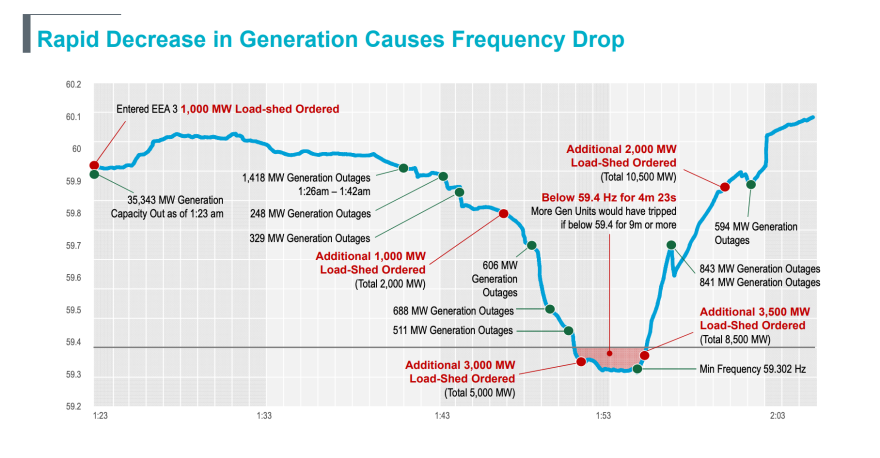We’ve heard Texas’ power grid came close to total failure early the morning of Feb. 15, but not exactly how close.
Officials at the Electric Reliability Council of Texas (ERCOT), which manages the state’s grid, showed its board a timeline Wednesday of events leading up to the grid's near-collapse. That timeline showed the grid was just 4 minutes and 37 seconds away from a cascading series of events that could have left Texas in the dark for weeks — if not longer.
To keep the grid running, officials said, operators need to have enough power to maintain a constant frequency of around 60 hertz (you can learn more about that here). But on the evening of Sunday, Feb. 14, temperatures were falling, snow and ice were blanketing Texas, and people were turning up their thermostats.

Meanwhile, power plants across the state were going offline because of the cold weather; natural gas, coal, nuclear and wind energy sources were all failing. Equipment and pipelines were freezing up. At 12:15 a.m. Monday, ERCOT went to its first level of energy emergency alert.
RELATED | Here Are Some Terms You Need To Know To Understand The Debate Over The Texas Blackout
But that wasn’t enough. At 1:07 a.m., ERCOT went to the second level. This triggered some power reductions for industrial customers that volunteer to have power turned off when supply gets scarce.
Things kept getting worse. By 1:23 a.m., one-third of the state’s power-generation capacity was down. The highest alert was triggered, and ERCOT ordered power providers to start rolling blackouts.
If there’s not enough power on the grid to meet demand, ERCOT officials said, the frequency of the grid drops below that 60 hertz level. That can cause physical damage to equipment that moves power around the state. And it can force more power plants to shut down — possibly leading to a complete failure of the grid.
But those initial rolling blackouts didn’t solve the problem.
Still more power plants went offline because of the weather. And by 1:43 a.m. Monday, the frequency of the grid was falling to dangerous levels. At about 1:51 a.m., the grid dropped below 59.4 hertz. That may not sound much different than 60 hertz, but if the frequency stayed under that threshold for 9 minutes or more, ERCOT officials said, it would trigger that cascading failure of the grid.
Within minutes, the frequency fell to about 59.3 hertz. Grid operators told power providers to expand rolling blackouts again.
Four minutes and 23 seconds after it dipped below 59.4 hertz, the frequency began to rise as more customers were dumped from the grid. If it had stayed below that threshold for another 4 minutes and 37 seconds, the lights might still be out in Texas, ERCOT officials said.
“That is the thing that we cannot allow to happen,” said Bill Magness, ERCOT’s president and CEO, told the board Wednesday. “Because if we have a blackout of the system, the system is out for an indeterminate amount of time. We may still be here today talking about when is the power going to come back on if we had let the system get into that condition.”
By about 2:03 a.m., the grid was back at or above 60 hertz. But by that time, there was not enough power being produced to undo the blackouts — and as many of us know, some of the lights would stay out for days, until more power plants came back online.

















